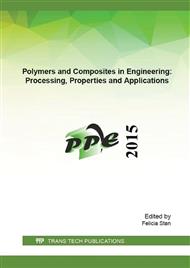p.49
p.57
p.63
p.71
p.80
p.86
p.91
p.97
p.104
Surface Analyses of Arboform Samples
Abstract:
Due to the global warming and diminishing petroleum oil reserves the conversion of biomass in useful biodegradable materials represent a tremendous need in terms of economic and environmental problem. During the last years, enormous effort have been sustained by the researchers who tried to develop and improve green (recyclable, biocompatible, and biodegradable) materials from renewable resources strengthening this way the global sustainability. Following this need a new material Arboform – „liquid wood“, that meets all the above conditions was developed by a team of german researchers appearing shortly on the market. This material can be processed like any other plastic material, so no need changing in terms of technological equipment. Since the injection molding is the most widely used process in manufacturing polymer products, unavoidable surface quality problems appear. In order to obtain a clear image of surface sample are analyzed the inherent properties of the used material, injection parameters and conditions using a Talysurf CLI 2000 profilometer. The equipment is able to perform high-accuracy measurements of the surface topography for Arboform L, V3 Nature (A-LW) and Arboform L, V3 Nature Reinforced with Aramid Fibers (A-LWAF) samples. The experimental research was achieved by means of the Taguchi experiment plan, with 6 input parameters (injection pressure, melt temperature, cooling time, screw displacement injection time and injection angle) each of them having two levels of variation. In case of 90 degrees angle injection (samples from 1 and 2 experiments) the dispersion roughness (Ra) measured on east-west direction is lower (26.6% for A-LW and 23.7% respectively for A-LWAF) compared with the roughness measurement on north-south direction. At 0 degrees angle injection the dispersion had the same trend (lower for east-west direction) of the A-LWAF 4 and 6 samples and higher in the east-west direction for 3 and 5 samples of A-LW material studied.
Info:
Periodical:
Pages:
80-85
Citation:
Online since:
July 2016
Keywords:
Price:
Сopyright:
© 2016 Trans Tech Publications Ltd. All Rights Reserved
Share:
Citation:


